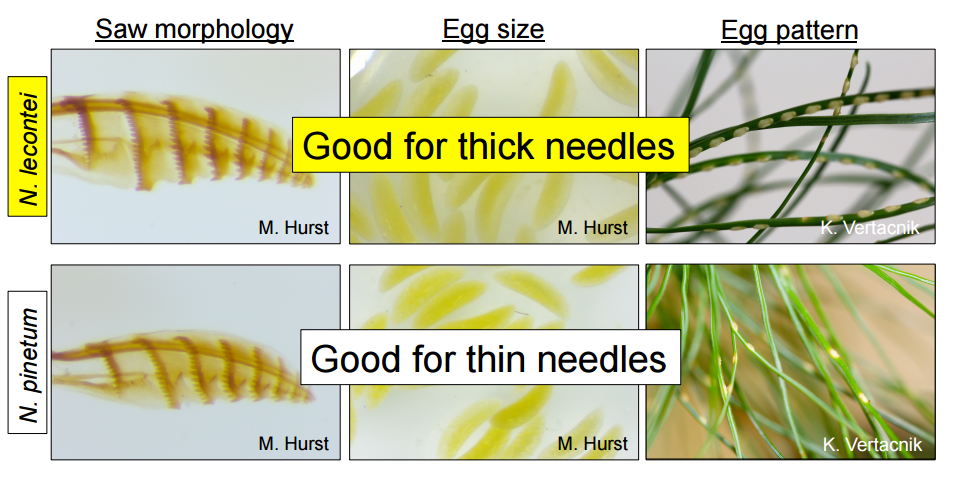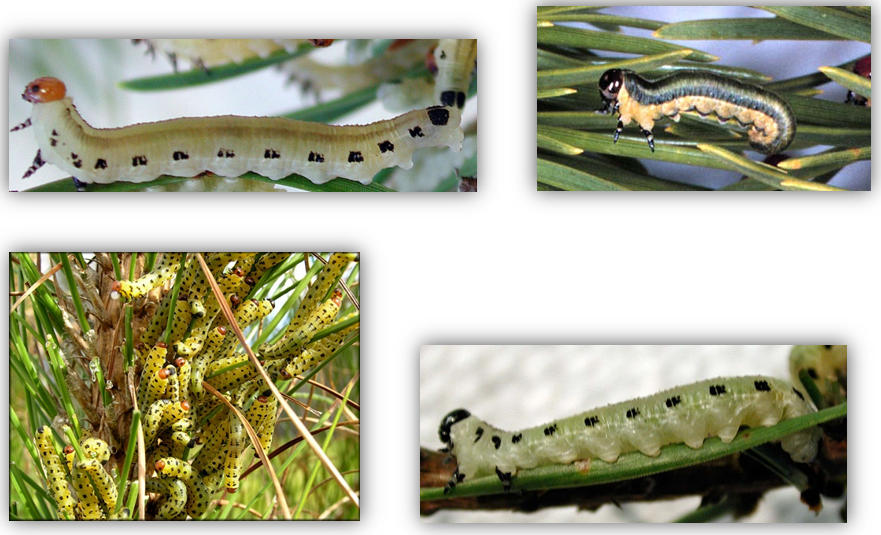|
What drives species apart: how does evolution turn one population into two populations that can no longer mate? This process is called speciation, and we have a lot to learn when it comes to this subject. Dr. Catherine Linnen, from the University of Kentucky, is using pine sawflies (genus Neodiprion) as a model to better understand the origins of biodiversity, from its proposed start as genetic mutations to eventual speciation. Pine sawflies have particularly diverse characteristics (or phenotypes) in terms of their body shape, larval coloration, social behavior, and host preference, though most use some type of pine trees. Since some of these species are pests, much their biology has been well studied. Speciation is easier to study in organisms showing divergent behaviors, preferences, and morphologies because these are all characteristics that evolution is proposed to act upon in the process of speciation. These qualities, in addition to the ease of their capture and lab-rearing, make them perfect for studies on speciation. How are differences in phenotype, such as host selection, driving populations apart into distinct species? What specific mutations are responsible for variations in phenotypes? Dr. Linnen proposed a phenotypic approach, which can be used to identify underlying genetic variation, using Neodiprion populations to help answer these questions 1. Can host preference separate populations into distinct species? In theory, this could happen in three steps: first, the colonization of a novel host; second, divergent selection on different traits; third, a reduction in gene flow leading to speciation. With a sizeable amount of biological data, Dr. Linnen was able to show that host use was the best predictor to model the speciation seen in Neodiprion species. Dr. Linnen showed an interesting example of this from her work on the saw-shaped egg-laying apparatus of adult sawflies, which is where these organisms get their common name. Different sawfly species have saws and eggs that fit well into the needles of specific host plants. In this case, she was investigating saw and egg differences of sawflies on pine trees with thick or thin needles. Since individuals with a thick saw would have lower fitness on host plants with thin needles, and since thin-sawed sawflies would ill-equipped to exploit hosts with thick needles, this trait could drive speciation. When looking at mitochondrial genes for proof of introgression (exchange of genes between distinct populations as a result of mating) between species, she showed that host difference seems to act as a barrier for introgression, as well.  Image shows variation in saw size and shape, egg size, and the typical spacing of eggs laid on different pine tree needles by Neodiprion lecontei and Neodiprion pinetum. These differences allow for these two species to specialize on different species of plants leading to potential spatial isolation even within the same geographic range. 2. Is there evidence of the same type of processes at the population level?
If yes, two individuals from the same species, but with different hosts should show higher genetic variation than a pair from the same host. The observed data supported this trend. After accounting for genetic variation due to geographical clusters, Dr. Linnen showed that divergent selection of hosts could drive differentiation between populations of a single Neodiprion species, potentially leading to speciation. 3. But how? Is host use reducing inter-breeding or is there a cost associated with inter-breeding in terms of fitness? Neodiprion females show preference when egg-laying: each prefer to lay eggs on their typical host. This behavior alone explains some spatial isolation resulting in reduction in gene flow. In addition, when females and males are placed together to test for mating preference, they prefer to mate with their conspecific (an individual of the same species), even in the absence of any host. This behavior indicates some level of sexual isolation, which would also reduce gene flow. However, in the lab, some individuals still chose a non-conspecific mate from the other host, resulting in hybrids. Hybrids were also collected in the field. Those observations, plus the results showing some level of mitochondrial introgression suggests that sexual isolation between Neodiprion species is incomplete. Host preference is associated with both survival and fecundity. Each species survives and reproduces better on its typical host. This amounts to a fitness cost for hybrid phenotypes resulting in underperformance compared to specialists on either host. Egg mortality was strongly linked to the matching of oviposition traits to the hosts. In particular, traits associated with thick-needles resulted in high mortality rates when eggs were laid on pines with thinner needles. What can sawflies tell us about speciation? Dr. Linnen’s work suggests that pine needle width is generating divergent selection pressure on host traits within and between populations of sawflies resulting in fitness costs for hybrid individuals and eventually driving speciation. By just considering how they lay eggs, sawflies can tell us a great deal. There is still more to learn as we explore the diversity of sawfly traits. References: Linnen, C.R. and B.D. Farrell. 2010. A test of the sympatric host race formation hypothesis in Neodiprion (Hymenoptera:Diprionidae). Proceedings of the Royal Society of London B. 277: 3131-3138. Bagley, R.K., V.C. Sousa, M.L. Niemiller, and C.R. Linnen. In Revision. History, geography, and host use shape genome-wide patterns of genetic differentiation in the redheaded pine sawfly (Neodiprion lecontei). Bendall, E.E., Vertacnik, K., and C.R. Linnen. In Prep. Selection on oviposition traits generates reproductive isolation between two pine sawfly species. About the Authors: Nathalie Steinhauer is a PhD candidate working in Dennis vanEngelsdorp’s lab on honey bee health and management practices. Her projects aims to identify and quantify the effects of risk factors associated with increased colony mortality. Samuel Ramsey is a doctoral student in Dennis vanEngelsdorp’s lab. His work focuses on honey bee parasites specifically targeting ectoparasite Varroa destructor and endoparasite Nosema ceranae. His project seeks to establish a deeper understanding of key aspects of both parasites’ biology with the aim of optimizing current IPM practices in respect to these organisms. Comments are closed.
|
Categories
All
Archives
June 2024
|
Department of Entomology
University of Maryland
4112 Plant Sciences Building
College Park, MD 20742-4454
USA
Telephone: 301.405.3911
Fax: 301.314.9290
University of Maryland
4112 Plant Sciences Building
College Park, MD 20742-4454
USA
Telephone: 301.405.3911
Fax: 301.314.9290



 RSS Feed
RSS Feed




